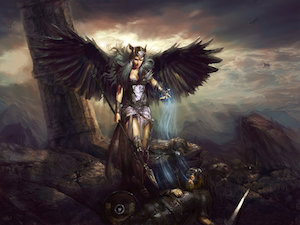
The Valkyries in popular culture.
The Valkyries were a collection of women in Norse mythology who decided which soldiers lived and died in battle. They were connected with a variety of animals, including swans and horses. Known in Old Norse as the ‘valkyrjur’–meaning “choosers of the fallen”–they flew over battlefields in search of skilled warriors, similar to the Celtic Morrigu. The chosen men were brought to Valhalla and watched over by Odin. There they trained to fight as ‘einherjar’ alongside Odin in preparation for Ragnarök. This mythological apocalypse was thought to be the end of the Norse cosmos before its recreation. The other fallen warriors were taken to the Fólkvangr, an afterlife also thought of as a training ground, but ruled over by the goddess Freyja.
As with most other characters in Norse Mythology, they appear in both the Poetic Edda and the Prose Edda. The poem “Völuspá” in the Poetic Edda identifies six Valkyries by name: Skuld, Skögul, Gunnr, Hildr, Göndul and Geirskögul. The poem “Grímnismál” expands the list to include Hrist, Mist, Skeggjöld, Hiökk, Herfjötur, Göll, Geirahöö, Randgríö, Ráögríö and Reginleif. Their original connection to the swan began in the Poetic Edda. The poem “Völundarkviõa” says, “Early in the morning, they found three women on the lake-shore, and they were spinning linen. Near them were their swan’s garments; they were Valkyries.” Their connection to spinning was identified in “Darraõarljöõ”, from the thirteenth century Njal’s Saga. It describes events that occurred between 960-1020CE. In it, twelve Valkyries sit at a loom, weaving the destiny of warriors about to participate in the Battle of Clontarf in Ireland. The imagery is gruesome; they used intestines for thread, severed heads for weights and swords as beaters, chanting their intentions over which soldiers will live or die. The shift from this grotesque perception of the Valkyries, to the more pleasant one today, is to do with the changing concept of Valhalla. This area of the afterlife was originally thought of as a battlefield; but it is now likened to a warrior’s paradise, enhancing the image of the Valkyries.
Since the thirteenth century, these warrior deities have been seen as much more pleasant. Besides training and waiting on warriors in Valhalla, they were thought to begin love affairs with strong men and legendary heroes. This would serve to both cemen thetir existence in the divine and strip them of their original demonic characteristics. They have also become conflated with the Germanic Norns. The Norns wereless violent female deities who had more of an overseeing role, like the Greek Fates. This could also explain their change in imagery. Later Norse mythology and modern popular culture have both portrayed Valkyries as golden haired maidens with fair skin and wings attached to their armour. They also appear as swan-maidens, who soar over battlefields handing out the fates of the soldiers that they see.
-Devon Allen
Junior Girl
Girl Museum Inc.
